10 Tips to Help Your Struggling Reader
Do you have a struggling reader? Whether you’re teaching a young child to read or helping a middle-schooler (or even a high-schooler) who has reading difficulties, it can be very stressful for both mom/teacher and child/student to deal with reading problems. However, don’t give up! There are several things you can do to lessen the stress and to help your struggling reader.
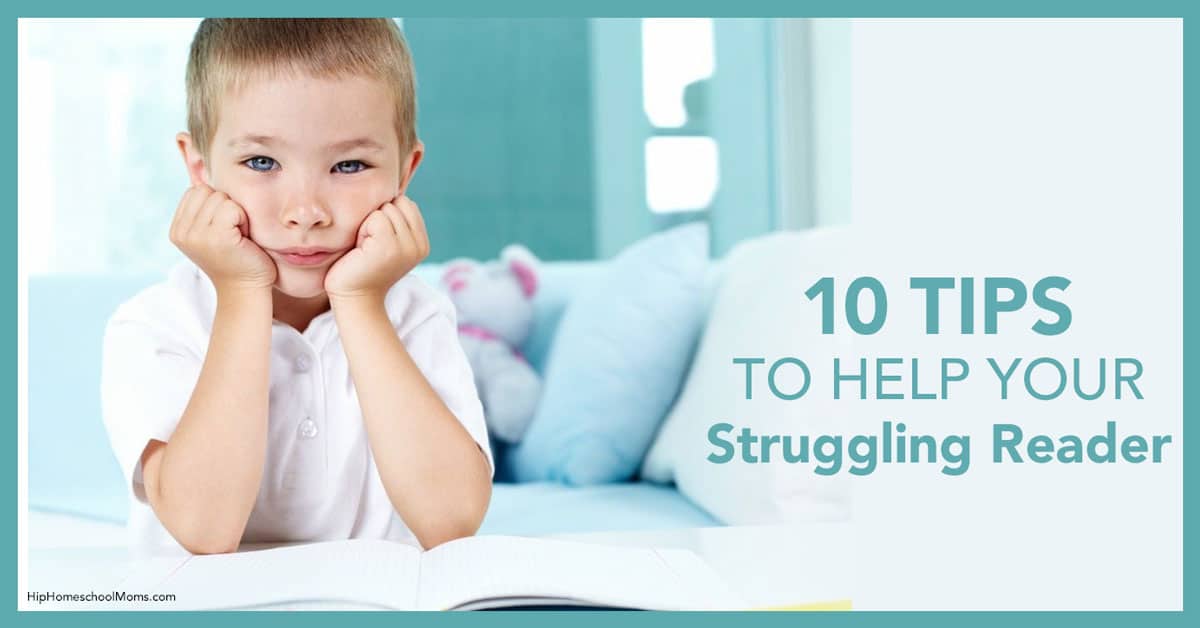
1. Decide if your child is ready to learn to read.
Sometimes we get so excited about homeschooling and teaching our children that we simply start doing formal schooling earlier than we should. You may want to read this article called Is Your Child Ready to Learn to Read? These 10 Tips Can Help You Find Out! for more information on determining if your child is ready to learn to read.
2. Read aloud to that child…often!
If you read tip #1 and reached the conclusion that maybe your child isn’t quite ready to learn to read, you can still enhance your child’s love of reading in a very simple way–read aloud! Reading aloud to your children – whether they read for themselves or not – is a wonderful way to give them great associations with reading. In addition to showing your kids that reading is fun, it can also create wonderful bonding time, help build vocabulary, and enhance their ability to imagine visual scenes to go with the words. All of these things help create readers.
3. Set realistic goals.
The child who enjoys reading sticks with reading. If you have a struggling reader, you may have frequently observed him getting frustrated or overwhelmed when trying to tackle large portions of reading. One thing you can do to make it easier on both of you is to re-adjust your goals. Are you asking your child to read something that is simply too difficult? Or could you ask him to read smaller amounts each day? While it can seem counter-intuitive to set smaller goals, sometimes that is what is needed to give your child the sense of success that he needs to feel encouraged instead of discouraged.
4. Tell your child the goal each day.
Before you begin the day’s reading lesson, tell your child the goal that she’s working toward. After the lesson each day, be sure to point out progress she made toward the goal that day. This also helps to encourage her and lets her know that you, the parent, are paying attention and that you’re proud of each effort she made!
5. Don’t try to force your child to read faster.
If your child reads slowly, that’s okay! Instead of trying to urge him to read faster, have patience. Speed and fluency often come with time and practice. Additionally, these are things that you can model (without pointing out you are doing so) as you read aloud. Pointing out slow reading won’t help–it will only discourage.
6. Use lots and lots of repetition.
If your child struggles with reading, you may need to have him practice the same words or stories over and over and over. It’s okay. Repetition helps to “cement” the information in his mind. Try to keep it fun, though, so he doesn’t get bored!
Try telling the story in funny voices or even acting it out to keep things exciting! One idea that can be really fun is to turn some of the words in the story into a “script” and act it out by making a video or performing a puppet show, etc. Get creative!
7. Teach/practice short vowels first.
After your child learns short vowels and 1-syllable words and can read them easily, then you can move on to long vowels. Most phonics programs do this for you, but it is something to keep in mind if you supplement or come up with your own practice words and sentences. A great series that starts out with short vowel sounds is The Bob Books!
Or, if you have a child who wants to learn to read and doesn’t want a fancy or colorful curriculum, he might enjoy learning to read using Alpha Phonics. My son (even when he was very young) simply wanted to quickly learn to read. He wasn’t interested in games or activities to make the process more fun. For that reason, I tried using Alpha Phonics with him. It was inexpensive and no-nonsense, and it was perfect for him! Very simply, it’s a book of word lists that takes your child through the process of learning short vowels (and long vowels later on), combining them with consonants, and continuing to build until he can read.
8. Use a multi-sensory approach.
Make sure you allow your child to use all of her senses when she’s learning to read. Some children learn best by seeing, some by hearing, some by touching things or doing things. Using a multi-sensory approach allows your child to use different senses, and that often increases learning and makes it more fun too! For example, you could use blocks to build words (using the child’s sense of touch), or play a sound game in the car, “What letters says ‘mmmmm’?” You could also finger paint words or build them with magnetic letters on the fridge. There are all sorts of ways to make this a multi-sensory process!
If you want to find out more about your child’s learning style, click here to read this article. You’ll find out more about your child’s learning style and how to meet his or her needs as you homeschool.
9. Try to find books that interest your child.
This is definitely one of the most important things to remember when teaching reading; it has to be interesting! If your struggling reader isn’t interested in the books or sentences you use in his instruction, he’s just not going to be very motivated to want to learn to read! Try to find books about topics that he particularly enjoys!
And if books are intimidating to your child, have him or her read whatever looks interesting! Magazines, comic books, or even cereal boxes will work in the beginning. Some parents steer away from books based on movies or television shows that a child likes, but I say go for it. If that’s what it takes to get your child interested in learning to read, it’s worth it! It may also be helpful because a familiar (and beloved) topic may help him better visualize the material and therefore learn more easily.
10. Start out easy.
It’s often best to begin with a book that is below your child’s current reading level. That allows her to have some success with reading. Then slowly progress to more difficult books. By doing this, she will be more motivated to learn to read, and motivation can make a big difference! If possible, you don’t want reading to be a chore.
It’s much better to start out easy and move slowly than to turn reading into a dreaded activity. Basically, success encourages more success! With reading, what you really want is to build your child’s enjoyment! Once a child learns to love reading, the rest tends to take care of itself.
Something Important to Keep in Mind:
If you feel like your child may have a problem such as dyslexia or some other kind of learning difference, physical problem (such as a vision problem), behavior issue, etc., that is causing him/her to have difficulty learning to read, it is important to see a doctor for help. There are treatments and therapies for problems with reading whether they are related to a learning difference, vision problem, or possibly even a behavior problem or some other kind of issue.
Do you have any tips for those who are teaching struggling readers? If so, please share them here! We would love to hear from you!


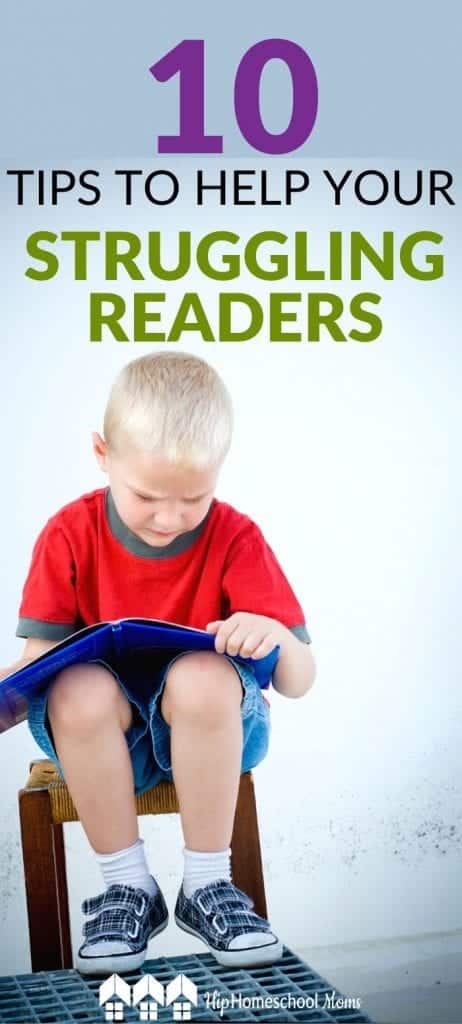

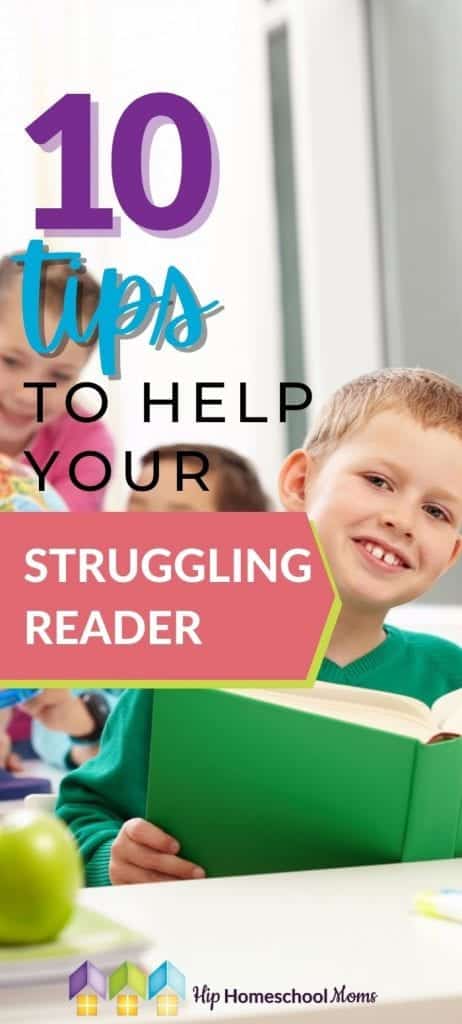
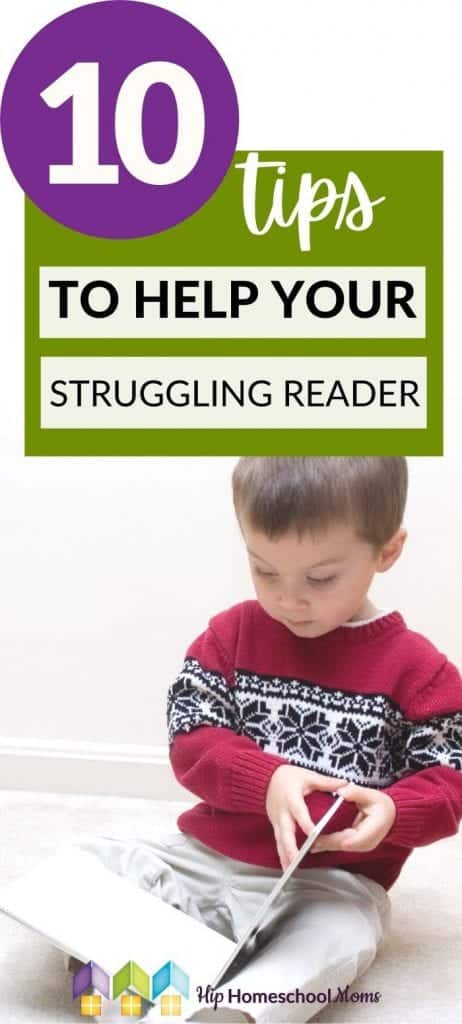
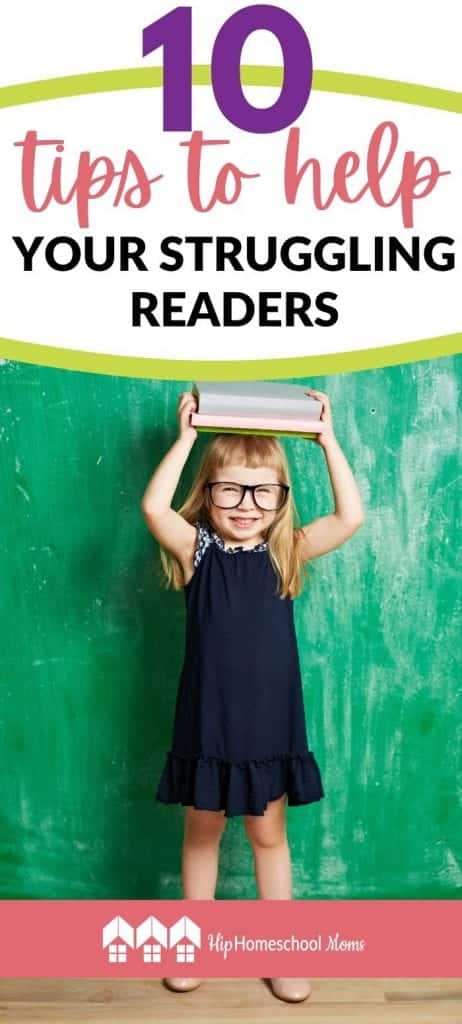








Great tips! I totally agree that you should not speeding your child up when they read. It can make the whole process really frustrating and give reading negative connotations for them.
Also finding interesting material for your child to read is very important.
Thanks for your comment, Albert!
I really love the Bob Books. When my child can read a book, we write their name and the date, and ……..can read this book. I also write the words on a post it, and have my child read the words with out the pictures. My oldest is dyslexic, so she struggle quite a bit. We just kept the faith, I would have to quit when frustration set in. Do not let not being able to read, delay learning. I read all of her other work to her, till she was able to get it on her own. In order to get her to try a chapter book, I bribed her with a kindle. If she would read a chapter book, I would buy her a kindle. It worked, but she has devoured the Harry Potter books, and stays up too late reading. It makes me so happy to see her read and enjoy it.
I’m so glad your daughter loves to read in spite of her challenges! You’re doing a great job with her!
Yes, I had a struggling reader. I am a reading teacher turned homeschool Mom. I know how to teach reading so I never imagined I would have a struggling reader. God knows how to keep life interesting!
I agree, age does not mean a child is ready to read. I stayed VERY positive with my son and took it slow. He NEVER knew he as a “struggling reader.” About age 8 things began to click. By age 9 he was reading independently with ease. He absolutely loves reading because it was never a chore or negative. He is an avid reader now, having just turned 10.
I like your tips . . . Yes, read aloud EVERY day. Allow a child to read simple books at first. Find books and topics that interest the child!
If you have a struggling reader, I encourage you to hang in there and keep it positive.
Jeannine, I think it’s great that your son never knew he was a struggling reader and that he loves to read now! I agree that he probably loves reading now because you never allowed the process to be seen as negative. I think so many of us get anxious and worried when our kids take a little longer than others to learn to read until our kiddos pick up on that and start to think of reading as being negative and stressful. Hooray for you and the great job you’re doing!
Thank you for your comment! I read the tips at the link you provided, and I especially liked #5 about making real world connections with the child’s reading. When I was teaching my son writing skills (how to correctly format a letter, how to indent, how to make sure his verb tense didn’t change in the middle of a paragraph or sentence, etc.), it made a huge difference with him when I had him write a letter to a video game company and write to a pen pal. Because he saw that writing was a skill he would need throughout his life, it made sense to him to learn to do it well. I think the same thing applies to reading. If the child sees it as something fun, helpful, and important, he will be much more likely to want to learn to read and to enjoy it! Thank you for sharing those tips with us!
Great advice/tips! Patience is a MUST!
Our youngest has a hard time with reading. We actually started over with simple phonics at the kindergarten level. He is in second grade but was revealed to see words he knew and could read on his own. We started this back in July and he have already progressed through the beginner level. He is enjoying reading more and his confidence has soared. He is well on his way to getting “up to speed”.
Keep your great articles and posts flowing. We all appreciate them.